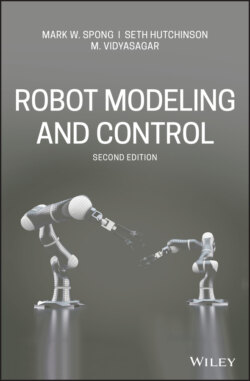Читать книгу Robot Modeling and Control - Mark W. Spong - Страница 25
1.2.4 Wrists and End Effectors
ОглавлениеThe joints in the kinematic chain between the arm and end effector are referred to as the wrist. The wrist joints are nearly always all revolute. It is increasingly common to design manipulators with spherical wrists, by which we mean wrists whose three joint axes intersect at a common point, known as the wrist center point. Such a spherical wrist is shown in Figure 1.8.
Figure 1.8 The spherical wrist. The axes of rotation of the spherical wrist are typically denoted roll, pitch, and yaw and intersect at a point called the wrist center point.
The spherical wrist greatly simplifies kinematic analysis, effectively allowing one to decouple the position and orientation of the end effector. Typically the manipulator will possess three DOF for position, which are produced by three or more joints in the arm. The number of DOF for orientation will then depend on the DOF of the wrist. It is common to find wrists having one, two, or three DOF depending on the application. For example, the SCARA robot shown in Figure 1.14 has four DOF: three for the arm, and one for the wrist, which has only a rotation about the final z-axis.
The arm and wrist assemblies of a robot are used primarily for positioning the hand, end effector, and any tool it may carry. It is the end effector or tool that actually performs the task. The simplest type of end effector is a gripper, such as shown in Figure 1.9, which is usually capable of only two actions, opening and closing. While this is adequate for materials transfer, some parts handling, or gripping simple tools, it is not adequate for other tasks such as welding, assembly, grinding, etc.
Figure 1.9 A two-finger gripper. (Photo courtesy of Robotiq, Inc.)
A great deal of research is therefore devoted to the design of special purpose end effectors as well as of tools that can be rapidly changed as the task dictates. Since we are concerned with the analysis and control of the manipulator itself and not in the particular application or end effector, we will not discuss the design of end effectors or the study of grasping and manipulation. There is also much research on the development of anthropomorphic hands such as that shown in Figure 1.10.
Figure 1.10 Anthropomorphic hand developed by Barrett Technologies. Such grippers allow for more dexterity and the ability to manipulate objects of various sizes and geometries. (Photo courtesy of Barrett Technologies.)
